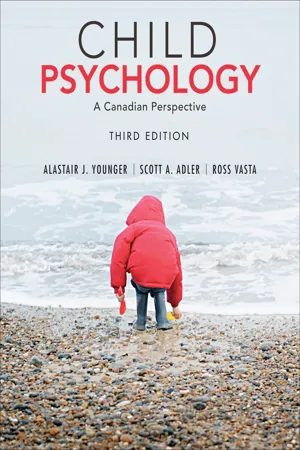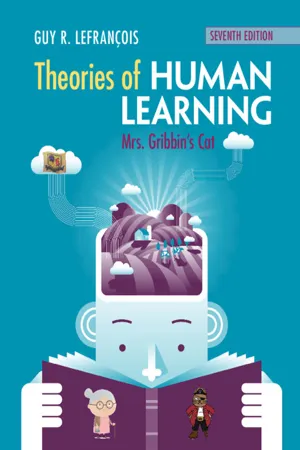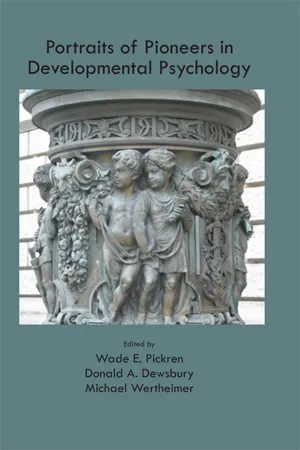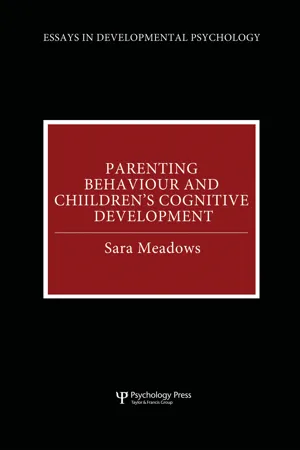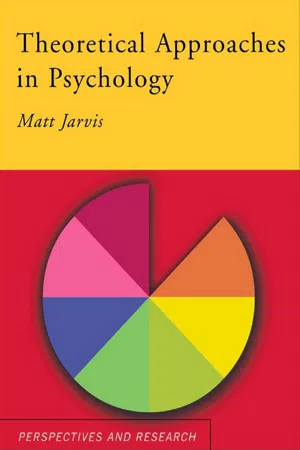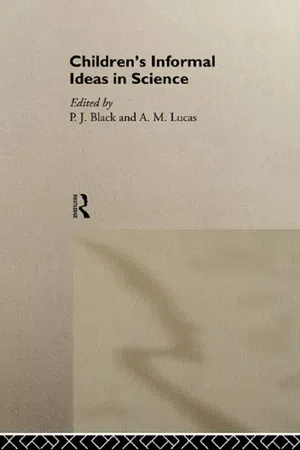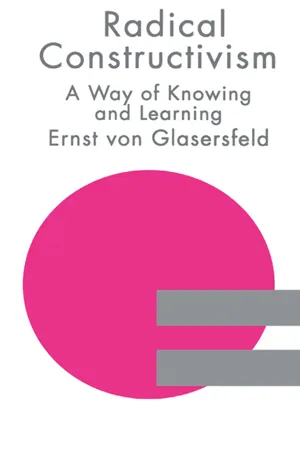Psychology
Piagets Theory in Education
Piaget's theory in education emphasizes the importance of active learning and the role of cognitive development in the learning process. It suggests that educators should tailor their teaching methods to match the cognitive abilities of students at different developmental stages. This approach encourages hands-on learning experiences and promotes the development of critical thinking skills.
Written by Perlego with AI-assistance
Related key terms
1 of 5
10 Key excerpts on "Piagets Theory in Education"
- eBook - PDF
Child Psychology
A Canadian Perspective
- Alastair Younger, Scott A. Adler, Ross Vasta(Authors)
- 2014(Publication Date)
- Wiley(Publisher)
Three main principles underlie Piagetian approaches to education. One is an emphasis on discovery learning or active learning. This emphasis relates to Piaget’s belief that children learn by acting on the world, not by passively taking in information. Piaget distrusted educational meth- ods that are too passive, rote, or verbal. In his view, education should build on the child’s natural curiosity and natural tendency to act on the world to understand it. Knowledge is more meaningful when children construct it them- selves rather than when it is imposed on them. A second, related principle arises from Piaget’s mechanisms of development—assimilation, accommodation, and equilibration— and their timing. Piaget believed that, while all children go through the same sequence of stages, they do so at their own pace. A child’s readiness to learn depends on the child’s current level of thinking. Experience—educational or otherwise—does not simply happen to the child; rather, the child must always integrate it with ex- isting cognitive structures through the processes of assimilation and accommodation. A new experience will be beneficial only if the child can make some sense of it. In addition, a child’s motiva- tion to learn depends on the timing of educational experiences. For children to move ahead in their cognitive development, they must experience disequilibrium, or a challenge to their thinking. Thus, development takes place when children are ready for an experience, and the experience provokes them to advance their level of thinking. A third principle, based on the idea that children move through cognitive stages at dif- ferent rates, is that teachers must be sensitive to individual differences among students in a classroom. Piaget’s diagnostics about what a child does or does not know at different stages of development helps teachers to understand where the child is in development and what naturally comes next. - eBook - PDF
Theories of Human Learning
Mrs Gribbin's Cat
- Guy R. Lefrançois(Author)
- 2019(Publication Date)
- Cambridge University Press(Publisher)
However, largely because of its emphasis on the development of knowledge, it is also a theory of learning. As a theory of learning, it can be simplified and reduced to the following set of statements: • The acquisition of knowledge is a gradual developmental process made possible through the interaction of the child with the environment. • The sophistication of children’s representation of the world is a function of their stage of development. That stage is defined by the thought structures they then possess. Table 7.2 Piaget’s stages of cognitive development Stage Approximate age Major characteristics Sensorimotor 0–2 years World of the here and now No language, no thought in early stages Motoric intelligence No notion of objective reality Preoperational Preconceptual Intuitive 2–7 years 2–4 years 4–7 years Egocentric thought Reason dominated by perception Intuitive rather than logical solutions Inability to conserve Concrete operations 7–11/12 years Ability to conserve Logic of classes and relations Understanding of numbers Thinking bound to concrete Development of reversibility in thought Formal operations 11/12–14/15 years Complete generality of thought Propositional thinking Ability to deal with the hypothetical Development of strong idealism Adapted from Lefrançois, G. R. (2018). Psychology for Teaching (2nd ed.). San Diego, CA: Bridgepoint Education, table 2.4. Used by permission. 272 Three Cognitive Theories • Maturation, active experience, equilibration, and social interaction are the forces that shape learning (Piaget, 1961). Maturation is a biologically based process related to the gradual unfolding of potential. Active experience refers to actual activities that enable the child to know and to internalize things. Social interaction (interaction with other people) permits the child to elaborate ideas about the world and about others. And equilibration is the tendency toward finding an optimal balance between assimilation and accommodation. - No longer available |Learn more
- (Author)
- 2014(Publication Date)
- The English Press(Publisher)
________________________ WORLD TECHNOLOGIES ________________________ Chapter-2 Piaget's Theory of Cognitive Development Piaget's theory of cognitive development is a comprehensive theory about the nature and development of human intelligence first developed by Jean Piaget. It is primarily known as a developmental stage theory, but in fact, it deals with the nature of knowledge itself and how humans come gradually to acquire it, construct it, and use it. Moreover, Piaget claims the idea that cognitive development is at the centre of human organism and language is contingent on cognitive development. Below, there is first a short description of Piaget's views about the nature of intelligence and then a description of the stages through which it develops until maturity. The Nature of Intelligence: Operative and Figurative Intelligence Piaget believed that reality is a dynamic system of continuous change, and as such is defined in reference to the two conditions that define dynamic systems that change. Specifically, he argued that reality involves transformations and states. Transformations refer to all manners of changes that a thing or person can undergo. States refer to the conditions or the appearances in which things or persons can be found between transformations. For example, there might be changes in shape or form (for instance, liquids are reshaped as they are transferred from one vessel to another, humans change in their characteristics as they grow older), in size (e.g., a series of coins on a table might be placed close to each other or far apart) in placement or location in space and time (e.g., various objects or persons might be found at one place at one time and at a different place at another time). Thus, Piaget argued, that if human intelligence is to be adaptive, it must have functions to represent both the transformational and the static aspects of reality. - Wade Pickren, Donald A. Dewsbury, Michael Wertheimer, Wade Pickren, Donald A. Dewsbury, Michael Wertheimer(Authors)
- 2012(Publication Date)
- Psychology Press(Publisher)
6Jean Piaget:Theorist of the Child’s Mind
BERNARD C. BEINSIthaca CollegeJean Piaget (b. August 9, 1896, d. September 16, 1980) has had more influence on the study of cognitive development than any other psychologist. As soon as his first books appeared, psychologists recognized the fertility of his ideas, even though those ideas had to make a linguistic journey from French to English, a translatlantic journey from Switzerland to the United States, and a methodological journey from more philosophical to more psychological. Piaget’s theory of cognitive development continues to dominate developmental psychology over 80 years after its introduction.Figure 6.1 Jean Piaget. (Courtesy of the Jean Piaget Society. With permission.)Piaget’s background mirrored that of the earliest generation of psychologists in his combined focus on the natural sciences and philosophy. Piaget credited his early work in the natural sciences with keeping his focus scientific, but he also maintained a European flavor to his ideas with a greater attachment to philosophy and logic than was common among psychologists in English-speaking countries at the time.Even with the shared background, however, Piaget developed his ideas largely independently of mainstream experimental psychology of the 1920s, which was already being led by English-speaking, behaviorally oriented psychologists in the United States. Piaget’s empirical approach was called “clinical,” relying on small samples and attention to children’s verbal statements to provide insights into cognitive processes. This approach was at variance with American psychology in that the latter had moved away from the study of mental processes that featured so prominently in Piaget’s work. In addition, whereas Piaget tended to study small numbers of children, American psychology had moved toward studying groups, averaging out the effect of unusual behaviors that might have been of great interest to Piaget. The few structuralists of Edward Bradford Titchener’s bent who remained active in psychology in Piaget’s early years would not have studied children because of the children’s relatively limited verbal skills. Their inability to report their introspections would have ruled them out as experimental participants.- Sara Meadows(Author)
- 2013(Publication Date)
- Psychology Press(Publisher)
The big divide, I think, is between those models where development is largely asocial and predominantly endogenous, and those where it is socially constituted or exogenous. There is a basic philosophical divide here which places Hegel on one side and Kant on the other (see, e.g. Markova, 1982); or, in contemporary work, at one extreme we have nativist theories postulating innate ideas (e.g. Fischer & Bidell, 1991; Fodor, 1981, 1983; and see also Plomin, 1994b; Plomin & McClearn, 1993) and at the other we are essentially constituted by our society (e.g. Bronfennbrenner & Ceci, 1993; Mayall, 1994). Most developmental psychologists agree that "cognitive development" involves change from a starting point which includes some innate predispositions, if not ideas, towards later states which vary in their content and in their sources, and that this change comes about largely through an active engagement of the individual with the physical and social worlds; however, emphases within this general agreement differ considerably. The debate in the psychology of cognitive development is embodied in the work of Piaget and Vygotsky. Each acknowledged that cognitive development is both endogenous and influenced by the outside social world, and each admired the other's work even when there were disagreements, but they developed different emphases, particularly regarding the role of adult-child interaction in the development of the child's cognition (Glassman. 1994; Van der Veer & Valsiner, 1991). I will outline their theories in turn. Piagetian theory has been understood as marginalising the role of adults in children's cognitive development, and so might be judged to be irrelevant to this essay, but an understanding of this child-centred approach is essential for an appreciation of the strengths and the problems of theory which takes the alternative approach and centres on adults' contributions to children's cognition.Piagetian Theory and Adult-Child Interaction in the Development of the Child’s Cognition
Piaget emphasised the biological nature of cognition, seeing it as one form of the general struggle for "adaptation" to the environment which is characteristic of all living organisms and at the heart of evolution, with the motive forces for this struggle being seen as predominantly endogenous. The Piagetian organism owes its development primarily to an innate and inevitable drive to adapt to its environment, through assimilating new information to the structures of knowledge which have already developed, and accommodating its existing structures of knowledge to accumulating new information. It is equipped with a need to "equilibrate"; that is, to maximise consistency, to eliminate contradiction and to ensure coherence in what it knows. It develops through equilibration's orchestration of three disparate things: physical maturation, primarily of the brain; reflection on its experience of the physical world and of the logical rules which can be applied to it; and finally and marginally, social interaction. The last factor is the least emphasised in Piagetian theory. The main form of social interaction which he saw as contributing to cognitive development was conflict with one's peers. This could lead to a recognition that one's own ideas were disagreed with by someone like oneself, and therefore might potentially be disagreed with by oneself too. (Equilibration is also, and more importantly perhaps, driven by the recognition that one actually disagrees with oneself, in an entirely endogenous cognitive conflict.) This recognition of a potential internal conflict is what prompts further reflection, and the revision of old ideas. Piaget (1932, 1968, 1983) implied that disagreement with someone unlike oneself would not have this effect of sparking off an internal disagreement, because it would not be recognised as potentially one's own problem. Disagreement with an adult, especially correction by an adult, would have little benefit for true cognitive development both because adults are viewed as different by children and because the power difference complicates things; the Piagetian child may bow to the adult's authority to the extent of parroting the correction, but will not internalise it. The result of adult instruction in the Piagetian model is limited; it gives rise to passive copying of what the adult has said is right, which does not become integrated with what the child has worked out independently, and may be even more damaging in that it may prevent the child from discovering for him or herself what the adult has taught.- eBook - ePub
- Matt Jarvis(Author)
- 2005(Publication Date)
- Routledge(Publisher)
qualitatively different—i.e. children simply do not think in the same way as adults.This idea was extremely radical when Piaget started out, but it has now become generally accepted in cognitive-developmental psychology. In fact you may regard this as common sense. Piaget was interested both in how children learnt and in how they thought. We can have a look at these issues.How children learn
Piaget saw intellectual development as a process in which we construct an internal model of reality. In order to gain the information to construct this internal representation of the world we spend much of our childhood actively exploring ourselves and the outside world. You may have noticed that even very young children are inquisitive about their own abilities and about their surroundings. Piaget proposed that the child’s mental world contains two types of structure, schemas and operations.Schemas
Schemas are packets of information, each of which relates to one aspect of the world, including objects, actions and abstract concepts. Piaget believed that we are born with a few innate schemas which enable us to interact with others. During the first year of life we construct other schemas. An important early schema is the ‘me-schema’ which develops as the child realises during its first few months that it is a separate object from the surrounding world.When a child’s existing schemas are capable of explaining what it can perceive around it, it is said to be in a state of equilibrium. However, whenever the child meets a new situation that cannot be explained by its existing schemas it experiences the unpleasant sensation of disequilibrium. We are all instinctively driven to gain an understanding of the world and so escape disequilibrium. Piaget identified two processes by which equilibration takes place: assimilation and accommodation. - eBook - PDF
Teacher Education and the Pursuit of Wisdom
A Practical Guide for Education Philosophy Courses
- Sean Steel(Author)
- 2018(Publication Date)
Jean Piaget took great efforts to try to see the children he was studying: to really see them, and to understand them. What are their thoughts? How do they make sense of the world? What sorts of ways of thinking and understanding are typical of infants, toddlers, younger, and older children? Do they change or develop in their attitudes and understandings? Is there a natural progression to their develop- ment, or are they really just whatever we tell them to be? Piaget can help us see past many of the misconceptions that have plagued edu- cation, where perhaps we have had a tendency to take the manner in which the system runs and the methods of the system as sacrosanct, and where perhaps in the past we have just expected the children we teach to fit that system, rather than re-thinking our systems of education so that they better respond to the needs of the children. So many things besides learning drive education: government agendas, ideol- ogy, economics, social mores, public opinion, the fears, desires, and expectations as well as misunderstandings of parents. So many balls are being juggled in the air at the same time that it is a wonder how anyone receives a decent education. Teachers have a very important job, and they are in some ways miracle workers in the midst of all these competing demands and interests. Piaget’s Developmentalism vs. the “Factory” & “Banking” Models of Education Piaget’s developmentalism can help us to identify some of the problems in what has come to be known as “the factory model” of education. As we’ve already seen, that’s where students are treated like widgets on an assembly line; as they move down the line, teachers add knowledge, skills, and attitudes to them, like compo- nent parts. And it is we who determine what gets added when and where and how. The process has little to do with the children, considerations of their nature, or what is suited to them developmentally. - eBook - PDF
Developmental Psychology
Cognitive, Perceptuo-motor and Neuropsychological Perspectives
- C.-A. Hauert(Author)
- 1990(Publication Date)
- North Holland(Publisher)
The reason for this is not simply the result of a dramatic increase in empirical data on child development. The actual reason is undoubtedly related to theory. At the end of the 6 0 ' s . Piaget's theory of cognitive development provided a very strong framework in which a general and consistent answer to this question was possible. Therefore, part two of this introductory chapter will briefly review such an answer with a con- cise survey of some basic elements of Piagetian theory. 4 C-A. Hauert authors in this field ! In fact, developmental psychology has ex- ploded. Moreover, this situation is additionally stressed by the numerous and often trenchant positions on development proposed by the educators i.e., parents, teachers, politicians, journalists, etc. It will be useful, in the third part of this introduction to attempt to identify, from the 6 0 ' 9 , some relevant contributions in the field of developmental psychology that could be considered as possible detonators of this explosion. Finally, the fourth part of the chapter will pose the basic ques- tions --in our opinion-- facing the developmentalists today. These questions are more or less explicitely confronted throughout the book by all the contributors. Our understanding of the latest contributions to developmental psy- chology, as well as our analysis of some theoretical Piagetian themes, led us to bring together in one publication several current studies on cognitive, perceptuo-motor and neuropsychological deve- lopment. When it was dominant, Piagetian theory focussed almost exclusively on cognitive aspects of behavior. However, perhaps the theory declined because of its inability to incorporate increasing knowledge in the fields of perceptuo-motor and neuropsychological development. - eBook - ePub
- P. J. Black, A. M. Lucas(Authors)
- 2002(Publication Date)
- Routledge(Publisher)
From a methodological point of view, Piaget established a tradition. He went into schools and talked informally to children; he usually devised some interesting activity or task for the child to do as the focus of the conversation; but above all he listened to and valued what children said. This approach, known as the clinical method, has now been widely adopted, but unfortunately is sometimes not carried out with as much care as Piaget himself insisted on.Epistemological concerns were the focus of Piaget’s work and not psychology for its own sake. His essential quest was to understand knowledge—what it is and how it develops. More than this he wanted to know what types of knowledge were essential to our view of reality, with each of these informing an area of research. So Piaget’s main concern was to trace how these various areas of knowledge developed, with children illustrating development rather than speaking in their own right. Thus much of his research describes in detail children’s reactions to many hundreds of ingeniously conceived tasks within specific knowledge domains: for example, number, space and geometry, and physical quantities, to name only a few.Fundamentally what Piaget’s work showed was that children’s ideas about the world are importantly different from those of the adult, and certainly from those of the science teacher, and that if ‘knowledge’ is so evidently an evolutionary process, then all the stages leading up to it must be vital to the child. Thus the way in which children understand the world at any given moment, though to adults it may appear wrong, or strange, or even childish, is of great importance to them. Each new step in understanding is a necessary phase in its evolution; each new insight is like a springboard to the next stage.Piaget was interested in universals, in knowledge that was common to all individuals and in structures that would allow him to hypothesise mental links between very different conceptual domains. For Piaget, an individual’s thinking about reality was determined by his or her present mental structure.It is crucial to distinguish between the idea and discovery of structure and the way in which it is formalized. Many, not satisfied with Piaget’s structural models, have shown that they are not adequate representations of thinking. Such criticisms do not argue against structuralism but against the particular model chosen. Research is still going on around the issues of the nature of development, and problems of discontinuity or continuity. - eBook - ePub
- Ernst von Glasersfeld(Author)
- 2013(Publication Date)
- Routledge(Publisher)
Chapter 3Piaget’s Constructivist Theory of KnowingIt is a difficult task to glean a coherent theory of cognitive development from Piaget’s enormous body of work. Over a period of seventy years, Piaget published eighty-eight books, hundreds of articles, and edited countless reports of research that had been carried out under his supervision.1 His thinking and his ideas never ceased to develop, to branch out, and to spiral into new formulations which, in his mind, continuously expanded and modified what he had expressed in earlier writings. As a result, it requires considerable effort to sort out what seems to have remained the same and what was modified in the course of those decades. Those who venture to summarize Piaget’s ideas on the basis of two or three of his books have a limited perspective. They inevitably remain unaware of implications that cannot be grasped except from other parts of his work. Unfortunately, there are countless psychology textbooks and critical journal articles that fail in this respect. At best they provide an incomplete view of Piaget’s theory, at worst they perpetuate distortions of his key concepts. Many summarizers and critics, moreover, seem to have missed, or simply disregarded, the revolutionary approach to epistemology that Piaget developed as the basis of his investigations. This second failing is the more serious. Without the understanding that Piaget quite deliberately stepped out of the western philosophical tradition, it is impossible to come to a comprehensive view of his theory of knowing and the model he built to explain how children acquire knowledge.Piaget is not easy reading. Although he never ceased to praise the virtue of ‘decentration’ — the ability to shift one’s perspective —, he himself, as a writer, did not always try to put himself into his reader’s shoes. I feel that writing often was for him, as for many original thinkers, part of working out his ideas for himself. His untiring efforts to express his thoughts in the greatest possible detail do not always help the reader’s understanding. Yet, I never doubted that it was worth trying to overcome those difficulties, for the effort has led me to a view of human knowing that no other source could have provided.
Index pages curate the most relevant extracts from our library of academic textbooks. They’ve been created using an in-house natural language model (NLM), each adding context and meaning to key research topics.
